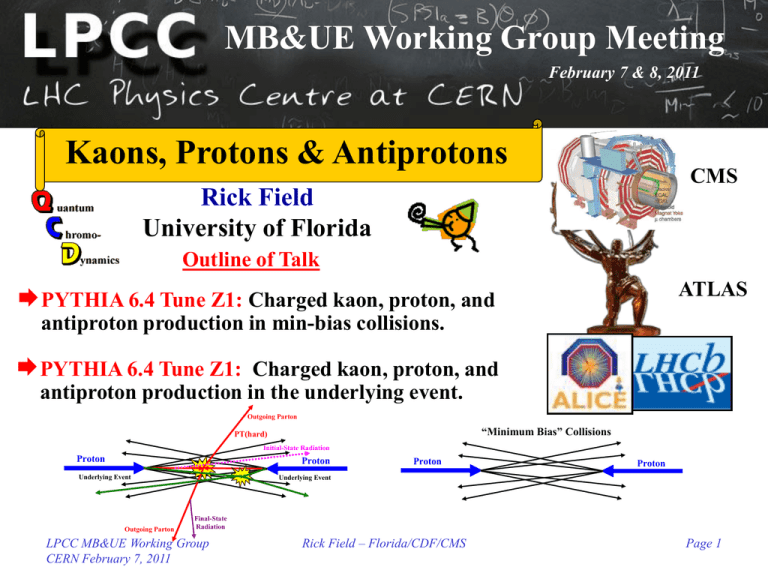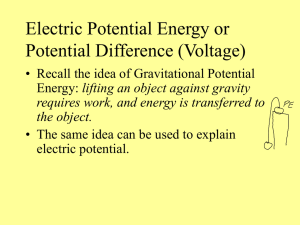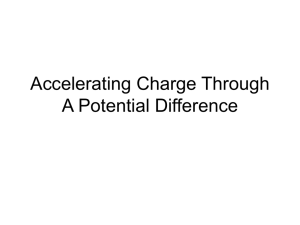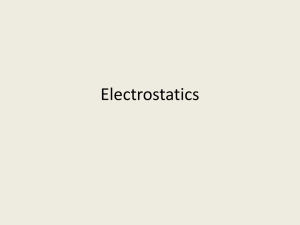MB&UE Working Group Meeting Kaons, Protons & Antiprotons Rick Field University of Florida
advertisement

MB&UE Working Group Meeting February 7 & 8, 2011 Kaons, Protons & Antiprotons CMS Rick Field University of Florida Outline of Talk ATLAS PYTHIA 6.4 Tune Z1: Charged kaon, proton, and antiproton production in min-bias collisions. PYTHIA 6.4 Tune Z1: Charged kaon, proton, and antiproton production in the underlying event. Outgoing Parton “Minimum Bias” Collisions PT(hard) Initial-State Radiation Proton Proton Underlying Event Outgoing Parton Proton Proton Underlying Event Final-State Radiation LPCC MB&UE Working Group CERN February 7, 2011 Rick Field – Florida/CDF/CMS Page 1 Strange Particle Production Factor of 2! ALICE preliminary stat. error only Jan Fiete Grosse-Oetringhaus LPCC MB&UE Meeting September 2010 Phojet Pythia ATLAS-CSC Pythia D6T Pythia Perugia-0 A lot more strange mesons at large pT than predicted by the Monte-Carlo Models! K/p ratio fairly independent of the center-of-mass energy. LPCC MB&UE Working Group CERN February 7, 2011 Rick Field – Florida/CDF/CMS Page 2 Charged Particle dN/dh 7 TeV Charged Particle Density: dN/dh Charged Particle Particle Density: Density: dN/dh dN/dh Charged 8 810.000 PYTHIA Tune Z1 7 TeV All pT ChargedParticle ParticleDensity Ratio Charged Charged Particle Density PYTHIA Tune Z1 ND 7 TeV pT > 0.5 GeV/c 6 pT > 1.0 GeV/c 4 2 0 INEL 6 1.000 All All pT pT pT > 0.5 GeV/c pT > 1.0 GeV/c pT > 2.0 GeV/c 4 0.100 ND pT >3.0 GeV/c DD 2 0.010 SD PYTHIA Tune Z1 ND 7 TeV 0 0.001 -10 -8 -6 -4 -2 0 2 4 6 8 10 -10 -10-8 -8 -6 PseudoRapidity h -6 -4 -4 -2 -2 0 0 2 2 44 66 88 10 10 PseudoRapidity PseudoRapidity h h Charged particle (direct, including leptons) pseudorapidity distribution, dN/dh (ND), at 7 TeV for all pT, pT > 0.5 GeV/c, pT > 1.0 GeV/c, pT > 2.0 GeV/c, and pT > 3.0 GeV/c from Tune Z1. Charged particle (direct, including leptons) pseudorapidity distribution, dN/dh, at 7 TeV for all pT from Tune Z1. Shows the individual contributions from ND, SD, DD, and INEL = ND + SD + DD. LPCC MB&UE Working Group CERN February 7, 2011 Rick Field – Florida/CDF/CMS Page 3 Charged Particle dN/dh 7 TeV Charged Particle Ratio: Flavor/All Charged 1.2 sum 1.2 All pT 1.0 0.8 p+ + p- 0.6 0.4 K + + K- proton sum PYTHIA Tune Z1 7 TeV INEL Charged Particle Ratio Charged Particle Ratio PYTHIA Tune Z1 7 TeV ND Charged Particle Ratio: Flavor/All Charged Antiproton 0.2 0.0 All pT 1.0 0.8 p+ + p- 0.6 proton 0.4 K + + K- Antiproton 0.2 0.0 -10 -8 -6 -4 -2 0 2 4 6 8 10 -10 -8 PseudoRapidity h -6 -4 -2 0 2 4 6 8 10 PseudoRapidity h Charged particle ratios versus h at 7 TeV (ND all pT). Shows (p+ +p-)/(all charged), (K+ + K-)/(all charged), proton/(all charged), antiproton/(all charged), and sum/(all charged), where sum = p+ + p- + K+ + K- + p + pbar. Charged particle ratios versus h at 7 TeV (INEL = ND + SD +DD all pT). Shows (p+ +p-)/(all charged), (K+ + K-)/(all charged), proton/(all charged), antiproton/(all charged), and sum/(all charged), where sum = p+ + p- + K+ + K- + p + pbar. LPCC MB&UE Working Group CERN February 7, 2011 Rick Field – Florida/CDF/CMS Page 4 Charged Particle dN/dh 7 TeV Charged Particle Particle Ratio: Ratio: Flavor/All Flavor/All Charged Charged Charged ChargedParticle ParticleRatio: Ratio:Flavor/All Flavor/AllCharged Charged Charged 1.2 1.2 1.2 sum sum sum pTGeV/c pT All 1.0 pT >> 3.0 GeV/c 1.0 1.0 1.0 Charged ChargedParticle ParticleRatio Ratio Charged Charged Particle Particle Ratio Ratio PYTHIA PYTHIA Tune Tune Z1 Z1 77 TeV TeV ND ND 1.2 1.2 p+ + p- 0.8 0.8 0.8 p+ + p- 0.6 0.6 0.6 p +p + 0.4 0.4 0.4 ++ + K Antiproton KK + KK- + + K-Antiproton Antiproton proton proton proton 0.2 0.2 0.2 0.0 0.0 0.0 -10 -10 -10 1.0 1.0 PYTHIA Tune Z1 7 TeV ND PYTHIA Tune Z1 7 TeV ND sum sum pT0.5 > 2.0 GeV/c pT > GeV/c p+ + p- 0.8 0.8 0.6 0.6 + proton p + p Antiproton Antiproton K+ + K K+ + K - 0.4 0.4 proton 0.2 0.2 0.0 0.0 -8 -8 -8 -6 -6 -6 -4 -4 -4 -2 -2 -2 000 222 444 666 888 10 10 10 -10 -10 -8 -8 -6 -6 -4 -4 -2 -2 00 22 44 66 88 10 10 PseudoRapidityhh PseudoRapidity PseudoRapidityhhh PseudoRapidity PseudoRapidity Charged particle ratios versus h at 7 TeV (ND all pT). Shows (p+ +p-)/(all charged), (K+ + K-)/(all charged), proton/(all charged), antiproton/(all charged), and sum/(all charged), where sum = p+ + p- + K+ + K- + p + pbar. Charged particle ratios versus h at 7 TeV (ND pT > 0.5 GeV/c). Shows (p+ +p-)/(all charged), (K+ + K-)/(all charged), proton/(all charged), antiproton/(all charged), and sum/(all charged), where sum = p+ + p- + K+ + K- + p + pbar. Charged particle ratios versus h at 7 TeV (ND pT > 1.0 GeV/c). Shows (p+ +p-)/(all charged), (K+ + K-)/(all charged), proton/(all charged), antiproton/(all charged), and sum/(all charged), where sum = p+ + p- + K+ + K- + p + pbar. LPCC MB&UE Working Group CERN February 7, 2011 Rick Field – Florida/CDF/CMS Page 5 Charged Particle Ratios Charged Particle Particle Ratio: Ratio: Flavor/All Flavor/All Charged Charged Charged sum sum PYTHIA Tune Tune Z1 Z1 77 TeV TeV INEL ND0.6 PYTHIA 1.0 1.0 0.6 0.6 + - K +K K+ + K- 0.4 0.4 0.2 0.2 0.0 0.0 00 11 Strange Particle Ratio PYTHIA Tune Z1 7 TeV 0.8 0.8 + p0.5 + pp+ + p- 0.4 pp++pbar pbar 0.3 sum PYTHIA Tune Z1 7 TeV ND 2 |h||h|< <0.8 Charged Particle Ratio 1.2 1.2 Charged Charged Particle Particle Ratio Ratio Charged Particle Ratio: Flavor/All Charged Strange Particle Ratio:1.2 (K+ + K-)/(p+ + p-) 1.0 |h| < 0.8 |h| < 0.8 0.8 p+ + p- 0.6 K+ + K- 0.4 p + pbar 0.2 0.2 0.0 220.1 PT (GeV/c) (GeV/c) PT 33 44 55 0 1 2 3 4 5 ND = open squares INEL = black dotsPT (GeV/c) 0.0 + 2.5+ 1.0 1.5 2.0 3.0 Charged particle ratios0.0versus p0.5 T at 7 TeV (ND |h| < 2). Shows (p +p )/(all charged), (K + K )/(all PTcharged), (GeV/c) charged), (p + pbar)/(all charged), and sum/(all where sum = p+ + p- + K+ + K- + p + pbar. Charged particle ratios versus pT at 7 TeV (ND |h| < 0.8). Shows (p+ +p-)/(all charged), (K+ + K)/(all charged), (p + pbar)/(all charged), and sum/(all charged), where sum = p+ + p- + K+ + K- + p + pbar. Charged particle ratios versus pT at 7 TeV (INEL |h| < 0.8). Shows (p+ +p-)/(all charged), (K+ + K)/(all charged), (p + pbar)/(all charged), and sum/(all charged), where sum = p+ + p- + K+ + K- + p + pbar. LPCC MB&UE Working Group CERN February 7, 2011 Rick Field – Florida/CDF/CMS Page 6 Charged Particle Ratios Charged Particle Ratio: Flavor/All Charged Charged Particle Charged Particle Ratio: Density: Flavor/AlldN/dh Charged + Strange Particle Ratio: (K + K-)/(p+ + p-) 1.2 8 1.2 sum 7 TeVAll pT 1.0 6 0.8 All pT Strange Particle Ratio PYTHIA Tune Z1 ND 0.5 p+ + 0.4 p- 4 0.6 0.4 2 0.2 proton K + + K- 0.3 Antiproton 900 GeV 0 0.0 -10 -8 -6 -4 -4 sum PYTHIA Tune Z1 900 GeV ND Charged Particle Ratio Charged Particle Ratio Charged Particle Density PYTHIA TeV ND0.6 PYTHIATune Tune Z1 Z1 7ND 1.0 All pT |h| < 0.8 0.8 p+ + p- 0.6 0.4 K + + K- proton Antiproton 0.2 0.2 0.0 -20.1 -2 00 22 PseudoRapidityhh PseudoRapidity 44 66 88 1010 -10 -8 -6 -4 -2 0 2 4 6 8 10 900 GeV = open squares PseudoRapidity h 7 TeV = black dots 0.0 0.0 0.5 1.0 1.5 2.0 distribution, 2.5 3.0 Charged particle (direct, including leptons) pseudorapidity dN/dh (ND all pT), at 7 PT (GeV/c) TeV and 900 GeV from Tune Z1. Charged particle ratios versus h at 900 GeV (ND all pT). Shows (p+ +p-)/(all charged), (K+ + K)/(all charged), proton/(all charged), antiproton/(all charged), and sum/(all charged), where sum = p+ + p- + K+ + K- + p + pbar. Charged particle ratios versus h at 7 TeV (ND all pT). Shows (p+ +p-)/(all charged), (K+ + K-)/(all charged), proton/(all charged), antiproton/(all charged), and sum/(all charged), where sum = p+ + p- + K+ + K- + p + pbar. LPCC MB&UE Working Group CERN February 7, 2011 Rick Field – Florida/CDF/CMS Page 7 Strange Particle Production Strange Particle Ratio: (K+ + K-)/(p+ + p-) 0.6 PYTHIA Tune Z1 ND 900 GeV |h| < 0.8 Factor of 2! Strange Particle Ratio 0.5 Plateau! 0.4 0.3 0.2 0.1 0.0 0.0 0.5 1.0 1.5 2.0 2.5 3.0 PT (GeV/c) A lot more strange mesons at large pT than predicted by the Monte-Carlo Models and a different shape of the curve! LPCC MB&UE Working Group CERN February 7, 2011 Rick Field – Florida/CDF/CMS Page 8 PYTHIA Fragmentation Parameters PARJ(1) : (D = 0.10) is P(qq)/P(q), the suppression of diquark-antidiquark pair production in the colour field, compared with quark–antiquark production. PARJ(2) : (D = 0.30) is P(s)/P(u), the suppression of s quark pair production in the field compared with u or d pair production. PARJ(3) : (D = 0.4) is (P(us)/P(ud))/(P(s)/P(d)), the extra suppression of strange diquark production compared with the normal suppression of strange quarks. PARJ(4) : (D = 0.05) is (1/3)P(ud1)/P(ud0), the suppression of spin 1 diquarks compared with spin 0 ones (excluding the factor 3 coming from spin counting). Look at the affect of changing PARJ(2) from 0.3 to 0.5! LPCC MB&UE Working Group CERN February 7, 2011 Rick Field – Florida/CDF/CMS Page 9 Charged Particle Ratios Charged Particle Ratio:Density: Flavor/All Charged Charged Particle dN/dh Charged Particle Ratio: Flavor/All Charged 1.2 8 1.2 All pT 0.0 0 0.0 0 -10 -10 0.5 p+ + p- p+ + p0.4 0.6 4 0.6 0.4 0.4 2 0.2 0.2 Strange Particle Ratio PYTHIA Tune Z1 ND 900 GeV s/u = 0.5 + - K +proton K -8-8 -6-61 -4 -4 0.3 sum sum PYTHIA = 0.5 PYTHIA Tune Tune Z1 Z1 77 TeV TeV ND ND s/u (s/u=0.5) Charged Charged Particle Particle Ratio Ratio 1.0 1.0 6 0.8 0.8 1.2 sum sum s/u = 0.3 All|h| pT< 0.8 (default) PYTHIA Tune Z1 ND0.6 PYTHIA Tune 77 TeV ND PYTHIA Tune Z1Z1 ND 7TeV TeV Charged Particle Ratio Charged ChargedParticle ParticleDensity Ratio Charged Particle Particle Ratio: Ratio: Flavor/All Flavor/All Charged Charged Charged Strange Particle Ratio: 1.2 (K+ + K-)/(p+ + p-) s/u = 0.5 K+ + Kp- + pbar Antiproton 0.2 1.0 1.0 All pT |h| < 0.8 |h| < 0.8 0.8 0.8 p+ + p- 0.6 0.6 p+ + pK+ proton + K- 0.4 0.4 Antiproton K+ + K- p + pbar 0.2 0.2 0.0 0.0 s/u = 0.3 (default) -2 -220.1 00 223 4 64 88 105 10 0 -10 -8 PT (GeV/c) hh PseudoRapidity PseudoRapidity -61 -4 -22 0 23 4 64 8 105 PT (GeV/c) h PseudoRapidity 0.0 0.0 including 0.5 leptons) 1.0 pseudorapidity 1.5 2.0distribution, 2.5 3.0 Charged particle (direct, dN/dh (ND all pT), at 7 PT (GeV/c) TeV for PARJ(2) = s/u = 0.3 (default) and PARJ(2) = s/u = 0.5 from Tune Z1. Charged particle ratios versus h at 7 TeV (ND all pT) with PARJ(2) = s/u = 0.3 (default) and PARJ(2) = s/u = 0.5 from Tune Z1. Shows (p+ +p-)/(all charged), (K+ + K-)/(all charged), proton/(all charged), antiproton/(all charged), and sum/(all charged), where sum = p+ + p- + K+ + K- + p + pbar. Charged particle ratios versus pT at 7 TeV (ND |h| < 0.8) with PARJ(2) = s/u = 0.3 (default) and PARJ(2) = s/u = 0.5 from Tune Z1. Shows (p+ +p-)/(all charged), (K+ + K-)/(all charged), (p + pbar)/(all charged), and sum/(all charged), where sum = p+ + p- + K+ + K- + p + pbar. LPCC MB&UE Working Group CERN February 7, 2011 Rick Field – Florida/CDF/CMS Page 10 Strange Particle Production Not good! Strange Particle Ratio: (K+ + K-)/(p+ + p-) 0.6 Plateau! PYTHIA Tune Z1 ND 900 GeV |h| < 0.8 Strange Particle Ratio 0.5 0.4 0.3 0.2 s/u = 0.5 0.1 0.0 0.0 0.5 1.0 1.5 2.0 2.5 3.0 PT (GeV/c) A lot more strange mesons at large pT than predicted by the Monte-Carlo Models and a different shape of the curve! LPCC MB&UE Working Group CERN February 7, 2011 Rick Field – Florida/CDF/CMS Page 11 Protons & Antiprotons Proton+AntiP Ratio: (p+pbar)/(p+ + p-) ALICE preliminary stat. error only 0.35 PYTHIA Tune Z1 ND 900 GeV |h| < 0.8 Jan Fiete Grosse-Oetringhaus LPCC MB&UE Meeting September 2010 Baryon Particle Ratio 0.30 0.25 0.20 0.15 Phojet Pythia ATLAS-CSC Pythia D6T Pythia Perugia-0 0.10 0.05 0.00 0.0 0.5 1.0 1.5 2.0 2.5 3.0 PT (GeV/c) Tune Z1 (ND) does not get this right either and this curve does not depend on PARJ(2)! LPCC MB&UE Working Group CERN February 7, 2011 Rick Field – Florida/CDF/CMS Page 12 The Underlying Event "Transverse" Charged Particle Density: dN/dhdf RDF Preliminary "Transverse" Charged Particle Density: dN/dhdf "Transverse" Charged Density "Transverse" Charged Density 1.2 7 TeV ALICE corrected data Tune Z1 generator level 0.8 900 GeV 0.4 ALICE Tune Z1 Charged Particles (|h|<0.8, PT>0.5 GeV/c) 1.2 RDF PreliminaryPTmax Direction 0.8 7 TeV f ATLAS corrected data Tune Z1 generator level “Toward” Leading Charged Particle, PTmax. 900 GeV “Transverse” 0.4 “Transverse” “Away” Tune Z1 ATLAS Charged Particles (|h|<2.5, PT>0.5 GeV/c) 0.0 0.0 0 5 10 15 20 25 0 2 6 8 10 12 14 16 18 ALICE preliminary data at 900 GeV and 7 TeV on the “transverse” charged particle density, dN/dhdf, as defined by the leading charged particle (PTmax) for charged particles with pT > 0.5 GeV/c and |h| < 0.8. The data are corrected and compared with PYTHIA Tune Z1 at the generator level. ATLAS preliminary data at 900 GeV and 7 TeV on the “transverse” charged PTsum density, dPT/dhdf, as defined by the leading charged particle (PTmax) for charged particles with pT > 0.5 GeV/c and |h| < 2.5. The data are corrected and compared with PYTHIA Tune Z1 at the generrator level. ALICE UE Data: Talk by S. Vallero ATLAS Note: ATLAS-CONF-2010-029 MPI@LHC 2010 Glasgow, Scotland May 29, 2010 November 30, 2010 LPCC MB&UE Working Group CERN February 7, 2011 20 PTmax (GeV/c) PTmax (GeV/c) I read the points off with a ruler! 4 Rick Field – Florida/CDF/CMS Page 13 “Transverse” Particle Ratios Leading Particle Ratio: Flavor/All Charged 1.2 1.2 sum PYTHIA Tune Z1 7 TeV ND |h| < 2 PYTHIA Tune Z1 7 TeV ND 1.0 Charged Particle Ratio Charged Particle Ratio "Transverse" Ratio: Flavor/All Charged PTmax Direction p+ + p- 0.8 0.6 + K +K 0.4 - p + pbar 0.2 1.0 f sum |h| < 2 pT > 0.5 GeV/c “Toward” 0.8 0.6 “Transverse” 0.4 p+ + p“Transverse” p + pbar K + + K- “Away” 0.2 0.0 0.0 0 2 4 6 8 10 0 2 4 6 8 10 PTmax (GeV/c) PTmax (GeV/c) Leading charged particle ratios versus pT at 7 TeV (|h| < 2.0). Shows (p+ +p-)/(all charged), (K+ + K-)/(all charged), (p + pbar)/(all charged), and sum/(all charged), where sum = p+ + p- + K+ + K- + p + pbar. Charged particle ratios in the “transverse” region (pT > 0.5 GeV/c, |h| < 2.0) versus the leading charged particle, PTmax, at 7 TeV. Shows (p+ +p-)/(all charged), (K+ + K-)/(all charged), (p + pbar)/(all charged), and sum/(all charged), where sum = p+ + p- + K+ + K- + p + pbar. LPCC MB&UE Working Group CERN February 7, 2011 Rick Field – Florida/CDF/CMS Page 14 Summary So far no luck at fitting the min-bias charged kaon to charged pion ratio. Increasing s/u produces more strange particles, but the shape of the curve versus pT is different! But I am just getting started at this! Also not getting the protons + antiprotons right. Changing PARJ(2) does nothing here! Must check out some of the other parameters The Monte-Carlo models are constrained by LEP data. Must make sure that I do not destroy the agreement with the LEP data! We need a better understanding and modeling of diffraction! protons Diffraction antiprotonss LPCC MB&UE Working Group CERN February 7, 2011 Rick Field – Florida/CDF/CMS Page 15







